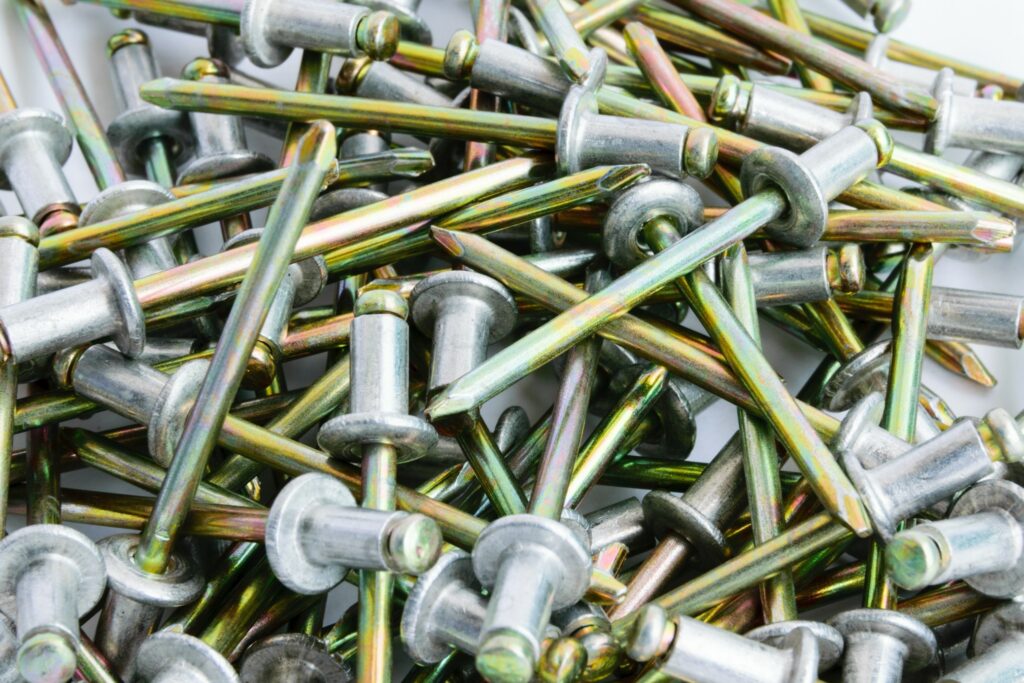With eight different types of rivets, it’s easy to feel overwhelmed when designing new assemblies. How do you know which ones to choose? What happens if your design flunks because you picked the wrong fasteners? Rapid prototyping helps remove the risk while maintaining budgets and schedules. Learn these facts before signing the contracts.
The types of rivets used in metal manufacturing are varied but essential. They play a critical role in countless projects as a substitute for nuts, bolts, and screws. They’re also more reliable and efficient for specific designs. However, manufacturers must choose the correct rivet types to connect parts for different purposes.
Machines and machining processes are dynamic, meaning they’re unique to the shop and tailored to the desired outcomes. Experts determine the rivet requirements for each design, following strict industry guidelines to produce particular properties. As a result, metal fabrication shops and manufacturing facilities often use rapid prototyping (RP) to create workable models with fabricated rivets.
The different rivets can offer excellent fastening abilities despite their form or function. They’re generally preferred for heavy-duty applications but are still feasible for lightweight connections. CNC operators use them in everything from sheet metal assemblies to aerospace components. The reason is that rivets can support various shear loads and tensile loads without fail.
Table of Contents
What Are the Different Eight Types of Rivets?
Rivets in Rapid Prototyping (RP)
Rivets Connect RP to the Manufacturing Industry
How to Choose Different Types of Rivets for Rapid Prototyping
What Is a Rivet?
Rivets, or pins, are mechanical fasteners that connect materials and maintain the position of various parts. Pins come in all shapes and sizes, yet they usually feature a head and tail on either end. They’re also semi-permanent or permanent. Therefore, many product designers troubleshoot blueprints with rapid prototyping to prevent unwanted mistakes.
Understanding how different types of rivets work is essential. Each one can either make or break an assembly. Further, some rivet types won’t meet ISO standards if shops combine them with the wrong materials. It would help if you asked your design team for more information.
How Rivets Work
Most rivets are made of steel, aluminum, or other durable alloys. However, handlers don’t tighten them like traditional nuts and bolts. Operators use tailored installation methods instead. They connect materials with rivets explicitly designed for each assembly. That way, the connection remains secure regardless of the overall application.
Operators generally install rivets with one of three techniques:
- Punching
- Drilling
- Tail Deformation
Experts can insert a rivet through a hole and bend its tail to create a durable bond. Most manufacturers prefer this method because it makes processing more straightforward and accessible. It’s also less expensive, faster, and uses fewer machines.
Pounding on a rivet head makes it expand to around 1.5 times the original size. The newly formed dumbbell shape helps hold parts steady regardless of movement or pressure. The connector then features two heads, allowing it to support heavy loads without buckling. However, durability depends on the types of rivets used and the connecting materials.

We offer fast, high-quality, tailored PROTOTYPING solutions for leading companies in a wide range of industries.
superior Rapid PROTOTYPING
What Are the Different Eight Types of Rivets?
There are several unique types of rivets to consider. You can also fabricate your own using simple DIY processes. However, professionally installed fasteners help ensure durable assemblies while maintaining safety protocols and obeying industry regulations. Hiring an expert is always your best bet.
Most machine shops let you choose between one of the following eight clasp varieties:
#1. Blind Rivets
Also known as hollow rivets or pop rivets, blind rivets are perfect for see-through assemblies. Manufacturers typically use them when they can see the other side of a connection. This rivet type is easy to install and ideal for aerospace, automotive, and electronic projects.
#2. Flush Rivets
These types of rivets are best for externally connected surfaces. They reduce drag and produce a more streamlined finish because they lay flush against the material. Manufacturers use countersunk heads and holes to create this smooth bond.
#3. Drive Rivets
Drive rivets feature short mandrels protruding from the head. Experts drive the part into a workpiece using a hammer. One end presents a flare that helps hold the materials together. The other end performs like a blind rivet, allowing visual access from one side.
#4. Oscar Rivets
These common types of rivets also function a lot like blind fasteners. Oscars feature slits along a hollow rod, usually in sets of three. The shaft can bend or flare to draw the mandrel to the connector. Then the protrusion creates a broader face to help reduce slippage.
#5. Solid Rivets
Roundhead pins, or solid clasps, are one of the oldest types of rivets in manufacturing history. Archaeologists discovered rudimentary forms dating back to the Bronze Age. Solid rivets are among the most reliable types because they’ve been around long enough to troubleshoot and redesign.
#6. Structural Steel Rivets
These rivet types are common in structural projects involving steel parts. They usually replace heavy-duty bolts that require installation by skilled tradespeople. Inexperienced workers can also tighten structural steel rivets without special equipment.
#7. Friction-Lock Rivets
Friction-lock rivets come in two distinct varieties. Engineers can use either dome-shaped or countersunk fasteners for different projects. FLRs are technically blind rivets. Therefore, they allow uncomplicated joins in complex designs, and aerospace clients often prefer them.
#8. Self-Piercing Rivets
You do not need to punch or drill holes for self-piercing rivets. A chamfered poke does all the work with these fasteners. Self-poking clasps pierce through the top layer without going through the bottom. They also create a watertight connection that’s perfect for precision links.
CNC machining and metal fabrication experts can tell you which types of rivets to use. Always ask for advice and insights before mass production. Or create workable models using rapid prototyping to troubleshoot design flaws.
Common Uses for Rivets
The types of rivets you choose don’t change their primary purpose. The point is to create a solid alignment using the most durable assortment of parts. You can join various metal alloys with ingenious riveting skills. Aluminum, titanium, and steel are no exception despite being a challenge to solder.
Riveted materials mean lightweight results with a cleaner finish. Meanwhile, engineers carefully select fasteners because each can change how a design operates. Pins should create a firm and durable bond between the two materials. Any miscalculation can compromise the outcome.
Picking the correct rivet type can help you avoid costly mistakes. It can also give you a better joint than traditional nuts, bolds, or screws. That’s why aircraft engineers prefer flush riveting over other material joining methods. Rivets in airplanes make traveling safer and more efficient.
Technically, riveting makes many things better. Here are three other uses for the different types of rivets in rapid prototyping and the modern economy:
Rivets for Jewelry Making
Do you know that bling on your finger? Chances are, it features tiny rivets that hold various components in place. Jewelry makers use cold joining methods to produce designer pieces. Cold connections require essential metal forming skills and basic tools instead of expensive metal fabrication devices. Thus, they can develop unique fashions without soldering metals.
Jewelry with rivets looks more streamlined and modern. Enhanced appearances might lead to more profitable sales and better brand recognition. Jewelers can choose their favorite types of rivets for different collections. Manufacturers can then create prototypes to help recreate or improve the best-selling designs.
DID YOU KNOW: Tiffany & Co. is world-famous for its “riveting” engagement ring designs.
Home Building Rivets
Look around your house. You’ll most likely find several items with rivets. Home goods and construction products use different types of fasteners for countless applications. Check the refrigerator, bathroom vanity, master bed, and laundry room for real-world examples.
Rivets are all over the exterior of your house – on the roofing, fencing, and siding, for instance. Your gutters probably stay connected because of weather-resistant clips instead of rusty nails. Strategic riveting helps hold your structure together despite the wind and rain.
DID YOU KNOW: You can remove permanent joins and semi-permanent connections with the correct technique.
Industrial Rivets
Durable, lightweight rivets make the industrial world go round. Construction workers prefer riveting over welding or bolting. They also witness longer-lasting products and machines with sophisticated joints. Strong links facilitate countless innovations, including some that are essential to our economy.
Modern homes wouldn’t have energy-efficient appliances, shelving, cabinetry, or furniture without rivets. Our factories would lack the machinery to produce and assemble. Life as we know it would be very different, if not challenging. We’d also live in a world without public transportation or skyscrapers.
DID YOU KNOW: World Trade Center builders used industrial rivets to help decrease the weight of each structure.
Rivets in Rapid Prototyping (RP)
How are the different types of rivets connected to rapid prototyping? What is rapid prototyping, and why do metal fabrication companies use it before mass production? Here is what you need to know.
What Is Rapid Prototyping?
Rapid prototyping, sometimes shortened to RP, is a manufacturing technique. It’s aimed at lowering production costs and shortening lead times through precision mitigation. In other words, RP produces a scale model of an object for examination. You can make (or remake) parts and assemblies without blowing your budget on the entire order.
Most RP modeling requires computer-numerical control (CNC) for accurate results. Operators fabricate components with automation and CAD/CAM programming. However, some experts call rapid prototyping “additive layer manufacturing” because they use inexpensive 3D printing machines instead. Both options need manufacturing software to support precision operations.
NOTE: Valuable RP creates workable examples using true-to-life features for an honest evaluation.

We offer fast, high-quality, tailored PROTOTYPING solutions for leading companies in a wide range of industries.
superior Rapid PROTOTYPING
Rivets Connect RP to the Manufacturing Industry
With eight different types of rivets, it’s easy to feel overwhelmed when designing new assemblies. How do you know which ones to choose? What happens if your design flunks because you picked the wrong fasteners? Rapid prototyping helps remove the risk while maintaining budgets and schedules. However, that’s not the only connection.
RP allows you to experiment with various clasps and troubleshoot inventions. It eliminates the need for industry regulations, giving engineers more freedom for creativity. The manufacturing sector depends on specific production standards, while the economy relies on innovation. Rapid prototyping is where the two meet.
Using the wrong rivet can be disastrous, especially for chief markets. Aerospace, automotive, medical, and structural engineering industries depend on ISO-regulated parts and assemblies. They can’t risk a bad connection, and neither can you. Let’s explore what you can do to avoid it.
How to Choose Different Types of Rivets for Rapid Prototyping
You can answer questions like, “What is rapid prototyping,” and “What are the different types of rivets.” Yet, you’re still unsure which rivet kinds to choose. These five points can help you narrow the search:
- Consider Your Design. Distinct elements and industry standards dictate your design parameters.
- Compare the Clasps. Look for distinguishing characteristics and double-check the finish.
- Consult the Crew. Ask your teammates for insights about the options and outcomes.
- Create a Mock-Up. Use rapid prototyping to your advantage for quick, efficient modeling.
- Consolidate Concepts. Turn big ideas into marketable products through collaboration.
Rivets and rapid prototyping services go hand in hand. The connection selection process is one of the most critical steps in designing and producing various assemblies. You cannot join materials without considering the clasp.
Conclusion
Different rivets and rapid prototyping techniques help companies innovate new products while respecting industry standards. The combination ensures strict adherence to regulations without restriction creativity. Rivets may come in all shapes and sizes, but RP lets you explore every possibility.
The most “riveting” thing about this is that each clasp type offers unique properties. Engineers often mix and match fasteners and hooks to develop exclusive concepts and branded products. Mindful RP experimentation with rivets means more freedom at a lower cost. The result is usually increased production and decreased waste.
Part of engineering is developing strategies for product upgrades and process streamlining. With rapid prototyping, you can accomplish both, making the option a refreshing alternative to blind mass production. Meanwhile, consult the experts and stay open-minded about the possibilities.
 About the Author
About the Author
James Murphy is the founder and CEO of HLH Rapid – a hybrid CNC machine shop fusing Western service and quality with Eurasian industry influences for over 14 years. His advanced enterprise uncovers cost-effective rapid injection molding techniques to remain unmatched by industry competitors. Murphy’s full-service fabrication and manufacturing methods span six dedicated zones, from 3D printing and vacuum casting to sheet metal prototyping and project management. His expertise also includes high-efficiency machining within strict yet volatile markets.
Murphy earned an MBA after becoming inspired by his father’s hands-on craftsmanship. As a budding entrepreneur, he taught English and studied Chinese to pursue pioneering objectives. His groundbreaking approach helps build the future by providing well-rounded manufacturing services to innovative Western businesses. When he’s not offering upscale RP and CNC, James enjoys art-house movies, Thai boxing, and spending time with his growing family.


